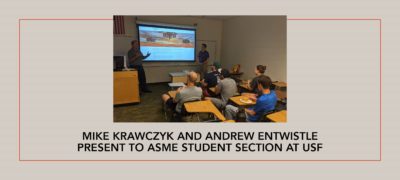

News
November 13, 2019
Mike Krawczyk and Andrew Entwistle Present to ASME Student Section at USF
McCormick Stevenson’s Mike Krawczyk, Principal Engineer, and Andrew Entwistle, Advanced Engineer, presented to the student section of the American Society of Mechanical Engineers (ASME) at the University of South Florida on October 29, 2019. Mike and Andrew provided an overview of how analysis is performed at McCormick Stevenson. Mike reviewed the “Ten Commandments of McCormick Stevenson Analysis,” stressing technical items such as the importance of first order analysis in conjunction with finite element analysis (FEA), and project-related items such as keeping your project manager updated on status and staying within your statement of work and budget. Andrew covered the setup and solving of a simple FEA model, from geometry prep to review of results. Andrew used a live session of ANSYS to cover all aspects of an analysis including geometry clean-up, FEA setup (materials, connections, mesh, boundary conditions, and loading), and results review. Mike and Andrew finished up the talk with a statement of the importance of having a firm grasp on first principles of engineering, so that analysts understand what is happening behind the “black box” of the FEA program, and to be sure they are using it correctly. They quoted McCormick Stevenson’s Chief Engineer, Barry Lindblom, telling the ASME members “You will (almost) always get the correct answer with FEA, but did you ask the correct question?” – another way of stressing the importance of understanding first principles and the theory behind FEA so that the analyst can be sure that their FEA model matches the reality he or she is trying to mimic. The evening concluded with a question and answer session between the students, Mike and Andrew, and MCCST’s Design Manager Nat McCormick, also in attendance.
ASME is a not-for-profit membership organization that enables collaboration, knowledge sharing, career enrichment, and skills development across all engineering disciplines, toward a goal of helping the global engineering community develop solutions to benefit lives and livelihoods. Founded in 1880 by a small group of leading industrialists, ASME has grown through the decades to include more than 100,000 members in 140+ countries and 32,000 student members.
